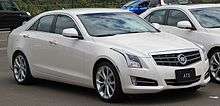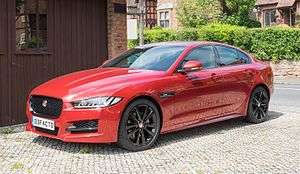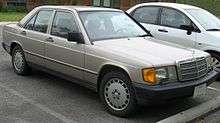Compact executive car
_%E2%80%93_Frontansicht%2C_30._Juli_2012%2C_Ratingen.jpg)
Compact executive car is a car classification term applied to premium cars smaller than executive cars. In European classification, compact executive cars are part of the D-segment. In North American terms, close equivalents are "compact premium car", "compact luxury car",[1] "entry-level luxury car" and "near-luxury car".[2] Compact executive cars are usually available in saloon, estate, coupé, and cabriolet body styles.
Most entry-level luxury cars are part of D-segment, but some cars like the Lincoln MKZ, Buick LaCrosse, Hyundai Azera, Acura TL and Toyota Avalon are part of E and F-segments despite the prices of D-segment premium and V6 mid-size cars.
History in the United States
The modern version of this market segment was successfully established in 1950 when "the Nash Rambler was deliberately conceived as a luxury compact rather than an austerity model" and available only as a convertible, with hardtop (no "B-pillar") and station wagon and models added in 1951.[3] By 1959, sales of European small cars and American Motors' Rambler "exploded" with many their buyers having above-average incomes leading commentators to describe "cultural motives behind their preferences" including the owners' "unconcern for symbols of success and importance that testified to the possession of the real thing."[4] Long-time president, chairman, and CEO of General Motors, Alfred P. Sloan, described the rising demand for compact cars was not motivated by economy, but "was essentially a further expression of the customer's desire for variety."[4]
By the early-1960s, the market for smaller, more economical cars, "but with more comfort, looks, and luxury" than ordinary compact cars included, among others, the Mercury Comet featuring style and interiors that "sparkle with most of the glamour Americans are accustomed to in their bigger cars."[5] During the late-1960s, buyer preferences fragmented the market, moving to intermediates, personal/specialty, and all-out luxury cars, while the demand slowed for traditional large cars.[6] Increasing fuel prices and competition pushed AMC to "exploit special market segments left untended by the giants.[7] In 1978, "AMC introduced its new Concord luxury compact"[8] "represent[ing] an upgraded, more luxurious, more comfortable, more silent, more opulent automobile."[9]

Cadillac continued its sales leadership in the premium market by making changes with the market and introduced the 1982 Cadillac Cimarron, a luxury version of the compact GM J platform.[10] The Cimarron helped to boost the automaker's Corporate Average Fuel Economy (CAFE), but its badge engineering of a front-drive, high-mileage model was evaluated as a low-value proposition in contrast to historic Cadillac luxury.[11]
Today, automakers are responding to changes in the marketplace and in the "mind-set" of consumers looking for status on a budget.[12] Traditional "luxury car makers are gearing up to offer small models that will test whether affluent U.S. car buyers are ready to concede that bigger isn't always better."[13] Facing higher fuel costs and traffic, changes are sweeping through the luxury car market and "Americans are beginning to catch up with global trends."[14]
History in Europe
United Kingdom

Two of the earliest European compact executives were created by the Nuffield Organization and introduced in 1952 under the MG and Wolseley brands. The badge engineered Magnette and 4/44 twins had monocoque construction[15] like the later Austin Cambridge rival, which was brought to the market in 1954.
BMC offered larger, Battista Farina designed saloons in 1959, which included the Austin Cambridge Mk. II, MG Magnette Mk. III, Morris Oxford Series V, Riley 4/68-4/72 and Wolseley 15/60-16/60 derivatives.
Other British compact executive contenders included the 1955 Hillman Minx, Singer Gazelle and sportier Sunbeam Rapier triplets from the Rootes Group. They were all replaced in 1966 with the Rootes Arrow range of cars - some of the last to be designed before the Chrysler takeover - and were made up of the Hillman New Minx and Hunter, Singer Gazelle VII and New Vogue as well as the top of the range Humber Sceptre Mk. III.
Standard's Vanguard (available as Sportsman, Ensign, Vignale and Six derivatives) appeared after 1955; the Standard name was discontinued in 1963 after Leyland bought them out. In 1965 Leyland introduced the Triumph 1300 which was their first front-wheel drive vehicle. This evolved into the Triumph 1500 before being re-engineered for rear-wheel drive for the 1970 Triumph Toledo and Dolomite twins. The latter was fitted with a 16v, SOHC engine and is considered the world's first mass-produced multi-valve car.[16]
By the time the Austin-Rover group formed in 1983, the Austin Montego - which was also available in sporting MG Montego guise - was about to be launched. Like the later Rover 600, Austin marketed the Montego as both a family and an executive car and correspondingly made it available with luxurious Vanden Plas trim and high-powered engines.

In 1993 Rover introduced the larger 600-Series which straddled the compact executive and large family car classes. It was based on the 5th generation European Honda Accord but was a more upmarket proposition.[17] The 600's replacement was the Rover 75, announced in 1998, which was also mid-sized and spawned a sportier MG ZT version. The Rover 75 continues in stretched form to this day[18] as the Roewe 750, also known as MG 750, predominantly for the Chinese and South American markets.
Like Rover, Jaguar's first compact executive competitor, the 2001 X-Type, was bigger than the class average, partly as a result of it being based on the Ford CD132 platform. Sales were disappointing[19] so its replacement, the XE, didn't appear until 2014 - the XE is far more closely aligned with the biggest-selling compact executive class cars.
Italy
Italian manufacturing group Fiat S.p.A. offered its 1961 Fiat 1300 as a 1500 model, with increased engine size for greater performance and prestige. This was followed by the Fiat 125 from 1967, Fiat 132 in 1972 and the related Argenta in 1981. FIAT no longer competes in the compact executive class. In 1962 Alfa Romeo started production of the Giulia sport sedan. The 116, 75, 155, 156 and 159 were the successors. Alfa Romeo was absent from the market for five years before returning with the new Giulia in 2016.
Lancia, along with MG and Wolseley, helped to establish the modern compact executive car in the early 1950s. Lancia launched the monocoque Appia in 1953, which took styling inspiration from the glamorous Lancia Aurelia. In a complete clean sheet design, Lancia introduced the Fulvia in 1963; this was the last model introduced before FIAT's takeover in 1969. The Lancia Beta was introduced in 1972 and this morphed into the Trevi by 1980. The Lancia Delta based Prisma was too small to be a serious compact executive competitor, so the larger Dedra replaced it in 1989 which was itself usurped by the Lybra in 1998. Lancia failed to make a success of its compact executive competitors in later years and left the sector in 2005.
Germany

During the period of economic progress in the mid-sixties in Germany, BMW introduced its 02 series. Nowadays BMW has two compact executive model lines: 3-Series (Saloon and Touring) and 4-Series (Coupé, Cabriolet and Gran Coupé). In 1983 Mercedes Benz introduced its 190E compact executive car.[20] Contemporary Mercedes-Benz compact executive automobiles are marketed under C-Class branding which is in its fourth generation.
Most of the Volkswagen Group's compact executives are produced by Audi which introduced its first competitor, the Audi F103 - derived fom the DKW F102 - in 1965. It was succeeded by the Audi 80 in 1972 before the A4 name began, of which there have been five generations. Contemporary Audi's compact executive models are A4 and A5. The SEAT Exeo was a lower-cost compact executive heavily based on the B7 Audi A4 but was discontinued after five years. Volkswagen introduced the upmarket CC to sit above the family-biased Passat in 2007.
France
Currently, only Citroën offers a car that could be considered a compact executive with its DS 5 hatchback. It forms part of the range of DS Automobiles, the new luxury brand of PSA. Peugeot and Renault never used compact executive cars, both concentrated on the large family car market.
Sweden
_%E2%80%93_Frontansicht%2C_26._Dezember_2013%2C_D%C3%BCsseldorf.jpg)
The Swedish brand Volvo has such compact executive automobiles as the 850 which evolved into the S70 saloon and V70 estate. Nowadays it offers the Volvo S60 and V60 in the compact executive car sector. Fellow Swedish brand Saab introduced the 99 in 1968 and replaced it with the 90 in 1984. Under GM control and on GM's GM2900 platform (which also underpins cars like the Vauxhall Cavalier and Opel Vectra), SAAB introduced the 900 (NG) which evolved into the first generation 9-3 in 1998. Saab's last compact executive car was the second-generation 9-3 which was produced from 2003 to 2014.
History in Japan
_Luxury_sedan_(2015-11-13)_01.jpg)
The Japanese luxury automobile market is rather younger than the European and American markets. There are three main premium car brands in Japan: Acura, Infiniti and Lexus which were all established in the mid to late 1980s. All three brands became popular in the US, but only Infiniti and Lexus are sold in Europe. The examples of the Japanese compact executive automobiles are Lexus IS (also known as the Toyota Altezza until the second generation), Infiniti Q50 (previously known as the G-Series), and the Acura TLX (a re-badged North American Honda Accord, which replaced the Acura TSX (which was a re-badged European Honda Accord itself)).
Mazda attempted to break into the compact executive market in the early 1990s with its own-brand Xedos 6. This was initially to be marketed under Mazda's luxury Amati brand, designed to take on Acura, Infiniti and Lexus. When the Amati project fell through the Xedos 6 continued in Europe badged as a Mazda and in Japan and Australia as the Eunos 500. When the Xedos 6 was discontinued in 1999, Mazda returned its focus to the large family car market.
Characteristics
Dimensionally, compact executive cars are smaller than mid-size/large family cars, and sometimes even smaller than compact cars. Mass market compact cars typically use the economical front wheel drive transverse engine layout, well suited to the inline-4 engine, which also maximizes interior room.[21] Several compact executive cars are rear-wheel drive with longitudinal engines, for improved stability and handling,[21] and in order to accommodate the larger size of higher-performance engines (straight-6, V6, rarely V8), with four-wheel drive often being available.[1] Compact executive cars also tend have more complicated independent suspensions, sportier transmissions, and high revolution engines that may require premium gasoline. The more complex powertrain and mechanical layouts of compact executive cars comes at increased cost and reduced interior passenger and trunk space.
Compact executive cars usually offer the buyer less equipment, interior room or engine horsepower for the money, compared to mass market (non-luxury) cars. However, the material and building quality is higher, there are exclusive features not found on mass market cars, there is better handling and performance, and the nameplate itself is part of the value proposition.[1] Recently, the entry-level luxury segment has been very competitive, and there has been price-overlapping with well-equipped non-luxury cars.[22][23] Today, many compact executive cars particularly emphasize sporty handling.[24][25] This category of vehicle is crucial to luxury marque BMW; BMW 3 Series accounts for up to 40% of the vehicles that BMW sells worldwide.[26]

The Citroën DS5 is an example of a compact executive car from the new premium (Luxury vehicle) sub-brand DS of the French automaker Citroën. The DS5 mixes hatchback and estate styling resembling a shooting-brake.
Other vehicles such as the Lexus ES, Acura TL, Acura TSX, and Chrysler 300 are also considered entry-level luxury in the United States and Canada, being similar in price to the BMW 3 Series and Mercedes-Benz C-Class.[27] However, the ES and TL are not sold in Europe and do not fall under European luxury classifications. The ES and TL actually began as badge engineered versions of the midsize Toyota Camry and Honda Accord, respectively, retaining the front wheel drive transverse engine layout platform with mass-market cars. The ES and TL are not considered executive cars either, despite similar dimensions, since executive cars usually emphasize higher performance, often being rear-wheel drive with longitudinal engines (the Chrysler 300 and 300C are examples).[24][25] The present iterations of the ES and LaCrosse emphasize "comfortable, reasonably priced luxury",[28] while the TL has recently been targeted at the entry-level luxury sport market.[27]
See also
- Category:Compact executive cars for a list of cars categorized as such
- Personal luxury car
- Compact car
- Large family car
- Mid-size car
- Sport compact
References
- 1 2 3 Cotta, Rick (30 October 2008). "The Consumer Guide to 2008 Premium Compact Cars". Consumer Guide Automotive. Archived from the original on 2008-11-09. Retrieved 2012-04-25.
- ↑ "Car Rankings: Best Upscale Midsize Cars - Best Cars & Trucks". U.S. News and World Report. U.S. News Rankings & Reviews. Retrieved 2015-04-08.
- ↑ Stevenson, Heon (2008). American automobile advertising, 1930-1980: an illustrated history. McFarland. p. 214. ISBN 9780786436859. Retrieved 2014-01-10.
- 1 2 Gartman, David (1994). Auto opium: a social history of American automobile design. Routledge. p. 170. ISBN 9780415105712. Retrieved 2014-01-10.
- ↑ Fermoyle, Ken (March 1960). "Comet: Ford's not-quite-so-compact car". Popular Science. 176 (2): 118–120. Retrieved 2014-01-10.
- ↑ "Family cars: The '69 cars". Popular Mechanics. 130 (4): 99. October 1968. Retrieved 2014-01-10.
- ↑ "Turnaround at American Motors". Fortune. 100: 66–80. 1979.
- ↑ Automobile club d'Italia (1978). World Cars 1978. Herald Books. p. 72. ISBN 9780910714105. Retrieved 2014-01-10.
- ↑ Lamm, Michael (May 1978). "PM owners report: American Motors Concord". Popular Mechanics. 149 (5): 124. Retrieved 2014-01-10.
- ↑ Auto Editors of Consumer Guide (26 March 2007). "1980-1989 Cadillac". auto.howstuffworks.com. Retrieved 2014-01-10.
- ↑ Lanning, Mike (2000). Delivering Profitable Value: A Revolutionary Framework to Accelerate Growth, Generate Wealth, and Rediscover the Heart of Business. Basic Books. pp. 184–185. ISBN 9780738201627. Retrieved 2014-01-10.
- ↑ White, Joseph B. (14 April 2012). "The 'Near Luxury' Car Buyer, Myth or Reality?". The Wall Street Journal. Retrieved 2014-01-10.
- ↑ White, Joseph B. (12 January 2012). "Luxury Car Makers Think Small". Wall Street Journal. Retrieved 2014-01-10.
- ↑ Eisenstein, Paul A. (24 January 2012). "For many luxury car buyers, small is now beautiful". msnbc.com. Archived from the original on 2 May 2012. Retrieved 2014-01-10.
- ↑ http://www.classiccars4sale.net/classic-car-review/aa-mg-magnette
- ↑ http://www.influx.co.uk/blog/triumph-dolomite-sprint/
- ↑ http://classics.honestjohn.co.uk/reviews/rover/600/
- ↑ http://www.saicmotor.co.uk/model.aspx?page=2
- ↑ http://www.jec.org.uk/x-types/82/x-type-model-information.html
- ↑ Car: The Definitive Visual History of the Automobile. DK Publishing. 2011. p. 15. ISBN 9780756689384. Retrieved 2012-05-09.
- 1 2 "Benefits of Rear Wheel Drive". Rearwheeldrive.org. Retrieved 2014-01-10.
- ↑ "How Mercedes got its groove back". Financialpost.com. 6 June 2009. Retrieved 2009-09-10.
- ↑ Van, Nicolas (4 June 2009). "Luxury makers smash August sales records in Canada". Ottawtizen.com. Archived from the original on 20 March 2012. Retrieved 2009-09-10.
- 1 2 "2010 Buick LaCrosse CXS vs. 2009 Lexus ES 350 Comparison Test and Video on Inside Line". Edmunds.com. 30 August 2009. Archived from the original on 4 September 2009. Retrieved 2009-09-14.
- 1 2 "Test Drive: 2009 BMW 328i xDrive". Autos Canada. 9 September 2009. Retrieved 2014-01-10.
- ↑ Williams, Paul (17 February 2005). "Retrospective: BMW 3 Series". Autos Canada. Retrieved 2014-01-10.
- 1 2 Bedard, Patrick (June 2009). "2009 Infiniti G37 vs. BMW 328i, Audi A4, and Acura TL- Comparison Tests". Caranddriver.com. Retrieved 2014-01-10.
- ↑ "2010 Buick LaCrosse vs. 2009 Lexus ES 350 Comparison Test". chiangmaicarhire.com. 31 July 2014. Archived from the original on 10 August 2014. Retrieved 2009-10-20.